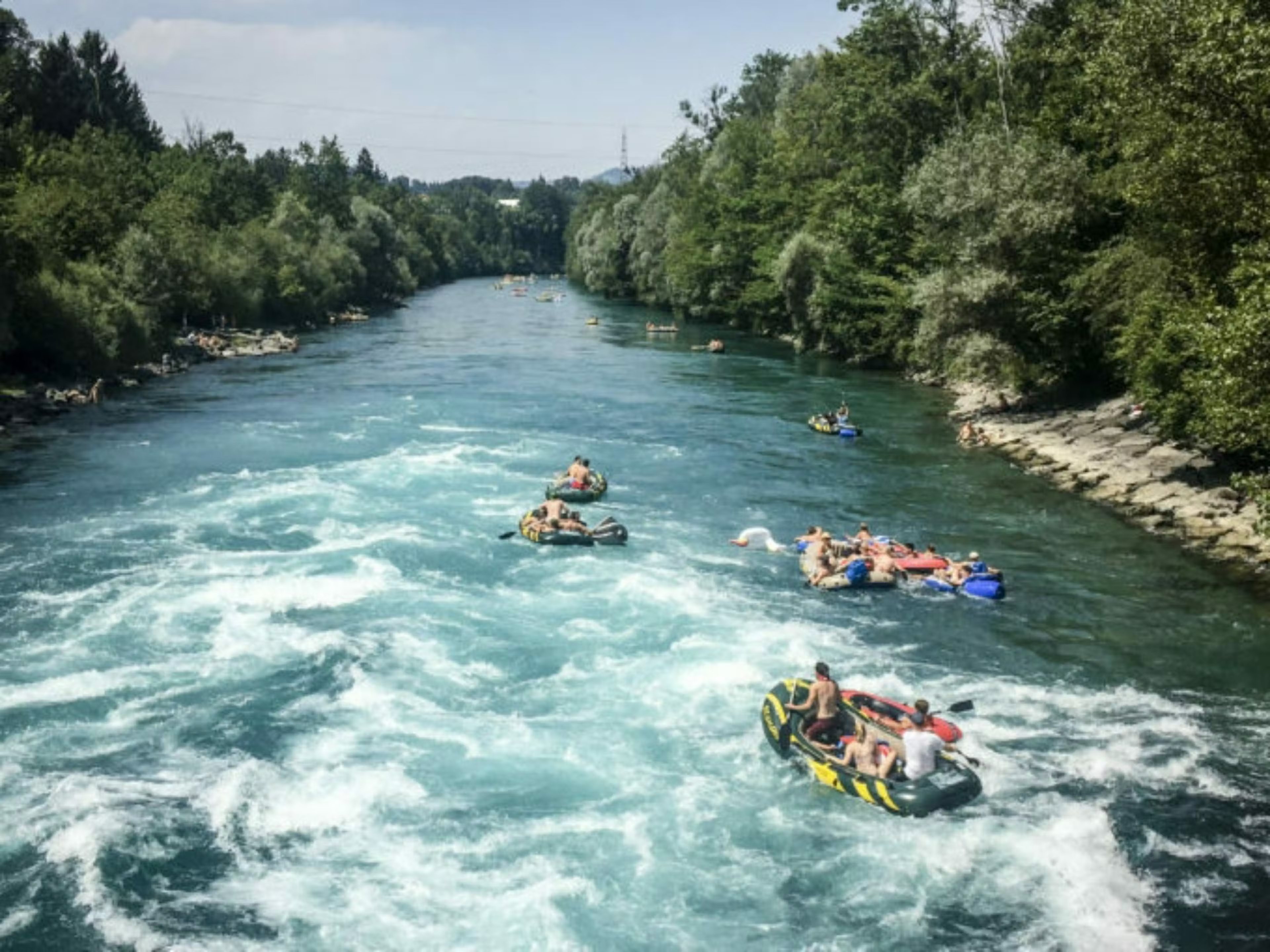
Rent
Boat hire for Aareböötle from Thun to Bern
Duration: 6 hours
Böötle is a particularly popular summer activity for families and friends. Böötle is the Swiss German word for floating down Swiss rivers in an inflatable boat, air mattress, inflatable boat or even a floating tire.
What do you do at Böötle? With the Böötle you get in with your floating vehicle at one point of the river and let yourself float. You can get off at any point and take the train or bus back to the starting point. Don't forget your waterproof bag with water, dry clothes, shoes and other things you need for the return.
This is very popular in Zurich, for example, where many friends, families, and couples float down the Limmat River in a small inflatable boat, a pink flamingo, or a floaty tire in the summer.
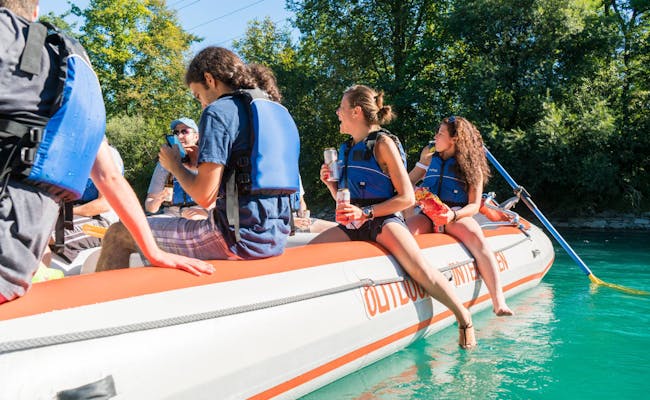 Aareböötle Bootsfahrt (Foto: Outdoor Interlaken)
Aareböötle Bootsfahrt (Foto: Outdoor Interlaken) Aareböötle vor Bern (Foto: Seraina Zellweger)
Aareböötle vor Bern (Foto: Seraina Zellweger)You are spoiled for choice when it comes to choosing the right route and the right river. At the bottom of the page you will find important information about equipment, safety and specific dangers when boating in the FAQ. Above all, it is important to start the exit in good time before danger spots, power stations and weirs.
When choosing the right route and the right river, you are spoiled for choice. We have compiled important information about equipment, safety and specific dangers when Böötle in the FAQ at the bottom. Above all, it is important to start the exit in time before danger spots, power plants and weirs.
There are several popular river tours in Switzerland. Here are first the 10 most beautiful Böötle tours briefly summarized:
Aare: Thun to Bern (3-4 hrs): This is the best known and most popular Aare rafting route, leading from Thun Schwäbis via the legendary Uttigen rapids to Bern. This route can also be shortened (Uttigen-Camping Eichholz)
Ticino (Ticino): Cresciano to Arbedo (1.5 to 2 hours): the river, still wild at the beginning, passes wooded slopes and gravel banks, plus the view of the Ticino Alps
Reuss: Bremgarten to Gebenstorf/Windisch (4 hrs.): a scenic stretch, but requires a lot of attention due to rapids and rocks as well as a weir behind Bremgarten; it can be shortened in Mellingen.
Rhine: Stein am Rhein to Schaffhausen (3.5 to 4.5 hrs.): along forests, weaving mountains and romantic villages, the route is leisurely to Schaffhausen with the gigantic Rhine Falls.
Linth: Being to Schmerikon (3 to 4 hours): The tour connects the Walensee with the Obersee.
Limmat: Zurich to Dietikon (2 to 2.5 hours): the route is much traveled and can for safety's sake also be started after the Höngger weir.
Saane/Aare: Gümmenen to Aarberg (3-4 hours): The trip leads from the Saane into the Aare, in parts it goes through a nature reserve (bathing is prohibited there)
Reuss: Sins to Rottenschwil (3-4 hrs.): the route on the Upper Reuss can already be started from Gisikon, the ride has hardly any dangerous spots
Rhine: Neuhausen am Rheinfall to Rheinau (3-4 hours): The impressive Rhine Falls can be admired at the beginning of a romantic tour to Rheinau Monastery.
Rhone: Geneva, Pont Sous-Terre - Geneva, Le Lignon (2-3 hours): The Böötle takes you through largely unknown parts of the Geneva region with beautiful bridges
Not everyone wants to buy their own rubber boat right away to pursue this recreational sport. A good alternative are boat rentals, which often even bring and fetch the boats. And for people who don't want to take care of anything themselves, there are guided Böötle.
The organizers have safety certification and public liability insurance. They offer certain routes, guide the rubber boats and watch out for obstacles and dangers. Both boat rentals and providers of guided tours are listed below for each river.
Guided tours are available between May and the end of October, depending on weather conditions.
 Aareböötle Bootsfahrt (Foto: Outdoor Interlaken)
Aareböötle Bootsfahrt (Foto: Outdoor Interlaken) Aareböötle Bootsfahrt (Foto: Marina Travel)
Aareböötle Bootsfahrt (Foto: Marina Travel)On the 27 km long stretch between Thun and Bern, a lot of rubber boats cavort to the Böötle in summer. This is no wonder, as this section is one of the most popular in Switzerland. In 2011, there were 598 boats with 1214 participants. This was the world record and an entry in the Guinness Book.
But also on the Kallnach- and Hagneckkanal you may drift with your rubber dinghy, it contains no danger spots.
You can also use the stretch between Schwellenmätteli and the weir Felsenau for a Böötle, this stretch is pleasantly quiet.
Between Wohlensee and Aargau there is a Böötle route that is considered a sporty alternative. This route is more of a rafting route and not for the lazy. You have to paddle together at full speed to make progress, as the Aare flows very slowly here.
You can find another eight suitable stages for a Böötle on the altogether 288 km long Aare between Biel (Nidau) and Full/Reuenthal:
Water level Aare: The recommended discharge in Brügg is: <400 m3/s.
 Aareböötle Bootsfahrt (Foto: Outdoor Interlaken).
Aareböötle Bootsfahrt (Foto: Outdoor Interlaken).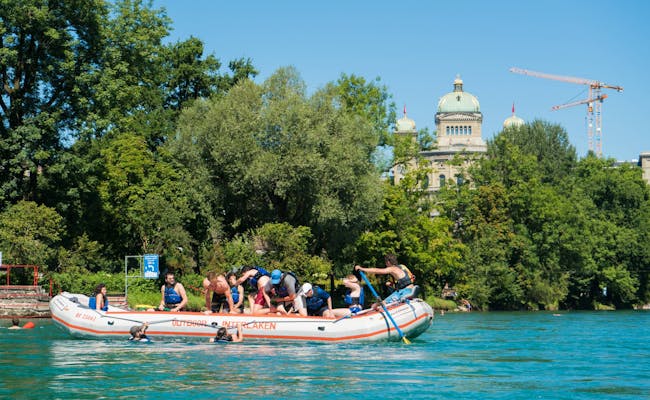 Aareböötle Bootsfahrt (Foto: Outdoor Interlaken).
Aareböötle Bootsfahrt (Foto: Outdoor Interlaken).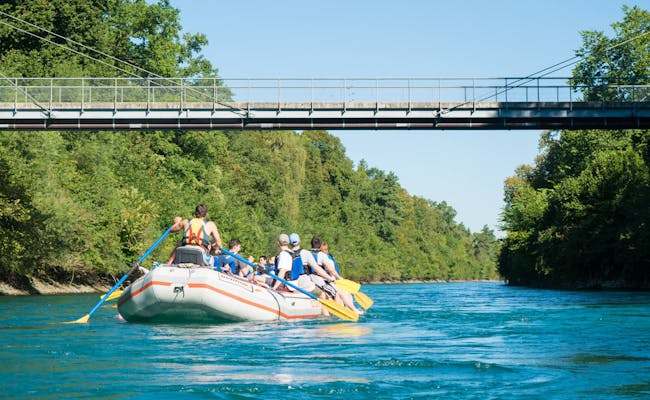 Aareböötle Bootsfahrt - (Foto: Outdoor Interlaken)
Aareböötle Bootsfahrt - (Foto: Outdoor Interlaken) Aareböötle (Foto: aarelauf.ch)
Aareböötle (Foto: aarelauf.ch)You should pay attention to the usual entry points for the Böötle. They are particularly suitable and have proven themselves.
The entry point in Thun is at Allmund-Schwäbis on the right-hand side of the river, behind the Regiebrücke bridge by the Bellevue restaurant. Schwäbis railroad station (Steffisburg) is right next to it.
There is another entry point in Uttigen after the railroad bridge on the left (5 minutes from the station).
In Bern the boarding point is in Schlipf at Schwellenmätteli, Dalmaziquai 11, right next to the Schwellenmätteli restaurants (5 min from the station).
In Worblaufen you will find the entry point 100 m after the Tiefenaubrücken bridges on the right (5 min from the station).
In Wohlensee you can generally get in anywhere. One possibility is the Wohleibrücke bridge, which is very suitable for boarding.
In Nidau am Bielersee you will find the entry point for Biel below the lock. The parking lot and WC are close by. The next entry point is near the Altreu information center at the bend in the river.
In Wangen a.A. you get in next to the Städtli bridge.
In Aarwangen at the Schlipf in front of the pontoon clubhouse, you can get in from the left before the castle
In Murgenthal at the steps in front of the Aare bridge from the right.
About five kilometers after the start in Thun, you reach the railroad bridge at Uttigen with the infamous Uttigen wave. Here you have to distribute the weights in the boat evenly and approach the wave in the middle.
Course ships and occasional ships you must regularly avoid and at ferry points a central driving is announced.
At Münsingen dead wood and shallows have to be taken into account.
For a stretch "around Bern", the Stauwehr Engehalde must be bypassed.
At Büsen, navigation of the Aare side arm "Häftli " is not permitted from spring to autumn.
Between Wangen a.A. and Murgenthal you will pass through two nature reserves where it is forbidden to enter or leave the water. Before the power station Wynau, the Aarestau Wynau and the old gravel pit Schwarzhäusern are such an area. You are allowed to drive through, but you have to keep a distance of ten meters to the shore. The same applies to the "Vogelraupfi" between Berken and Bannwil. You must drive around the island at a distance of at least 50 meters to the south.
After Wangen there are more and more hydroelectric power stations and before the respective weirs you absolutely have to ditch. Shortly before Aarwangen you reach the Bannwill power station (bypass on the left bank), after Aarwangen the Wynau/Schwarzhäusern power station (also bypass on the left bank), after Wolfwil comes the Aare-Cheer. You have to watch out for the waves! After Solothurn you reach the next power station: Ruppoldingen. Here you have to go around to the right.
Further danger spots are those of the Kehrwasser Aare-Waage near Aarburg and the Felsens Chessiloch before the wooden bridge Olten. The Aare is forced to make a sudden left turn at Aarburg by a rock spur. This creates a large sweeping water - called "Woog". The water flows back through the vortex. It is best to go around the Woog on the left side.
After Olten you drive between Trimbach and Winznau into the Kraftwerkskanal (power station Olten-Gösgen). Because of a current towards the weir, you have to drive entirely left along the bank.
The weir in Aarau (Rüchlig power station) must be approached carefully. The disembarkation requires special care. It is best to go right, because of the current towards the weir. Several boats should land one after the other.
In Brugg the rubber boat has to be carried for about 1,200 meters. For safety reasons, the deep and wild gorge should not be navigated.
The estuary of the Aare-Reuss-Limmat is called Water Castle. All islands belonging to it may not be entered
At the Klingnau Reservoir there is a protected area of international importance for waterfowl and migratory birds. You have to drive around all nature protection zones with a distance of 50 m and you have to follow the given access to the disembarkation point. In general, you are allowed to pass through the protected area, but not to stop or land.
The following exit points are tried and tested and should also be adhered to for safety reasons.
 Aareböötle Ausrüstung (Foto: aarelauf.ch)
Aareböötle Ausrüstung (Foto: aarelauf.ch)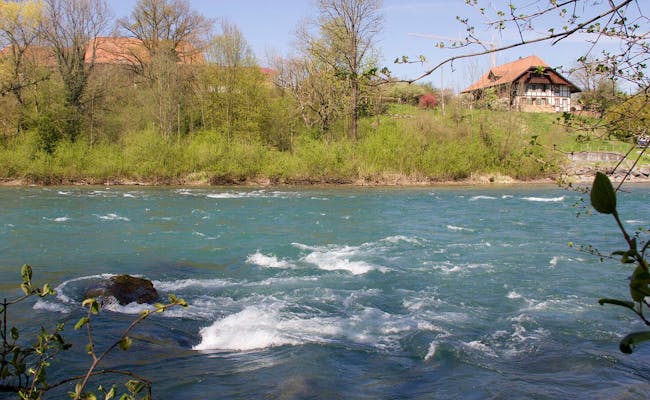 Aareböötle Jaberg Felsblock Bauernhof (Foto: aarelauf.ch)
Aareböötle Jaberg Felsblock Bauernhof (Foto: aarelauf.ch)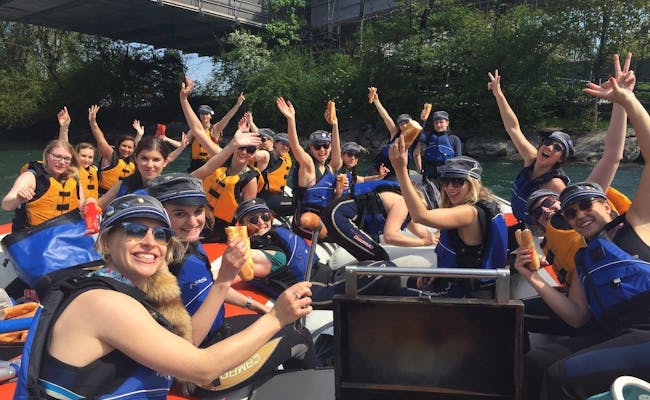 Aareböötle Bootsfahrt - (Foto: Outdoor Interlaken)
Aareböötle Bootsfahrt - (Foto: Outdoor Interlaken) Aareböötle Bootsfahrt - (Foto: Outdoor Interlaken)
Aareböötle Bootsfahrt - (Foto: Outdoor Interlaken)The most popular route for Limmat-Böötle is the one between Zurich and Dietikon. It is well connected to public transport and is always well frequented due to its proximity to the big city. The interesting mix of urbanity and beautiful nature offers a high recreational value.
The Limmat is very busy on the 10 km between Zurich and Dietikon, but you can also get on at the Höngg weir and save yourself the trouble of changing boats at the weir. The sections of the river bank that have been made natural by beavers begin after the Werdinsel behind the weir. The further stretch beyond Baden ends at Kappelerhof at the latest.
A popular boarding point is on the right side of the stairs of Wipkingerpark in Zurich. It can be reached directly by streetcar on line 13.
Bus and streetcar access. Directly after the Höngger Weir there is another boarding point. It is the place that is also reached on the left side after transferring the boats.
The Höngg weir is very dangerous. Time and again, people who have missed the exit have accidents here. The exit point before the Höngger Weir is on the left side.
You pass the Mühli weir on the left. The weir to Kraftwerk Aue must also be bypassed and you must disembark at the latest before the weir at Kraftwerk Kapellerhof.
On the stretch between Wipkingerpark and the Höngg weir (lower Limmat), according to the safety information of the city of Zurich, the Limmat should not be navigated by rubber dinghy when the discharge exceeds 100 m3/s.
The exit points before the Weir Höngg are signalized on the left bank. You can disembark at the concrete ramp. You have to carry the boats 60 meters on foot.
The Allmend Glanzenberg is a good place to get out of the boat, because you have a lot of space, toilets and direct access to the S-Bahn station Glanzenberg.
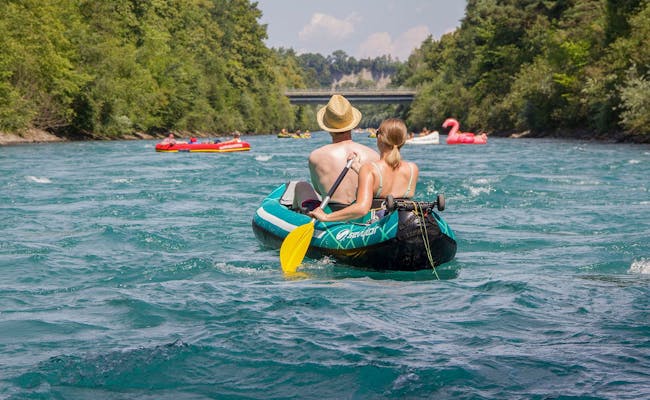 Aareböötle Heimberg Uetendorf (Foto: aarelauf.ch)
Aareböötle Heimberg Uetendorf (Foto: aarelauf.ch)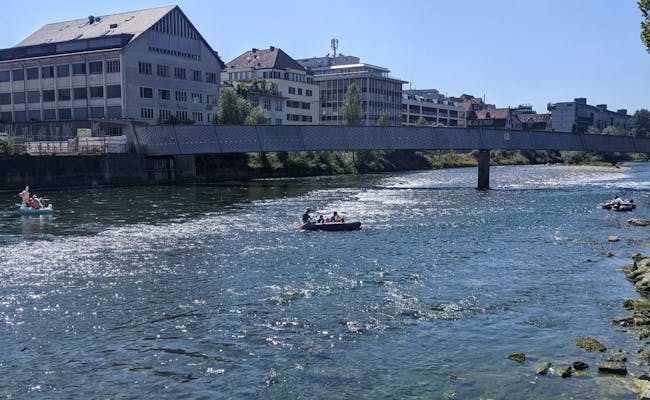 Limmat Böötle (Foto: Seraina Zellweger)
Limmat Böötle (Foto: Seraina Zellweger)The gently winding Reuss is a popular choice for river tours with rubber boats. The Reuss is an untouched body of water in many places. It offers plenty of calm but also has adventurous passages.
During your trip, you'll pass by some impressive bridges, like the beautiful wooden Zoll Bridge near Sins. You need to be aware of artificial obstacles and some weirs; otherwise, you can easily explore the Reuss with your inflatable boat. Besides calm stretches, there are also sections with strong currents.
Particularly the Lower Reuss requires your full attention. Always pay attention to warning signals and clarify possible entry and exit points in advance. Almost all stretches have options for an early exit.
The stretch between Bremgarten and Gebenstorf is a popular rafting route on the Reuss. It's 24 km long and belongs to the Lower Reuss. There are two more routes on the Upper Reuss between Sins and Rottenschwil as well as Gisikon and Rottenschwil.
The Reuss is the fourth largest river in Switzerland. Since it’s a glacial river, there are often higher water levels in June and July, especially after additional rainfall. So, rafting can be quite risky during these weather conditions.
The Lower Reuss is one of the most beautiful river stretches.
**#### Exit Points Gnadenthal, Mellingen, Gebenstorf
The Upper Reuss connects the locations Gisikon, Sins to Rottenschwil.
There are no particular hazard areas on the route. In Ottenbach at the diversion weir, you should stay to the left. Special care is required when encountering commercial ships.
The most popular exit point is Rottenschwil, left before the Reuss Bridge. Both the parking lot and bus stop Rottenschwil/Hecht are located directly at the exit. However, you can also exit in Ottenbach beforehand. You must exit before the Bremgarten power plant because of the weir.
**
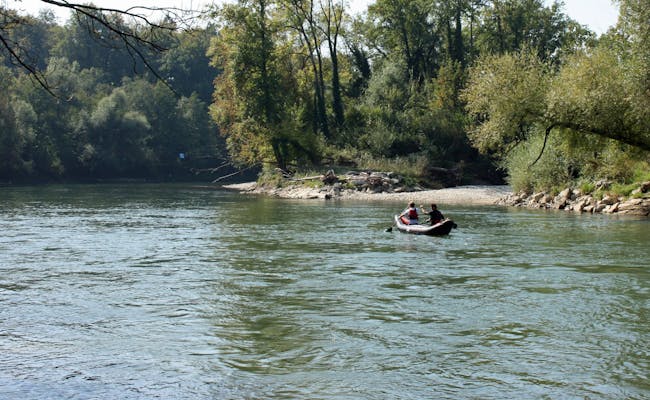 Reuss
Reuss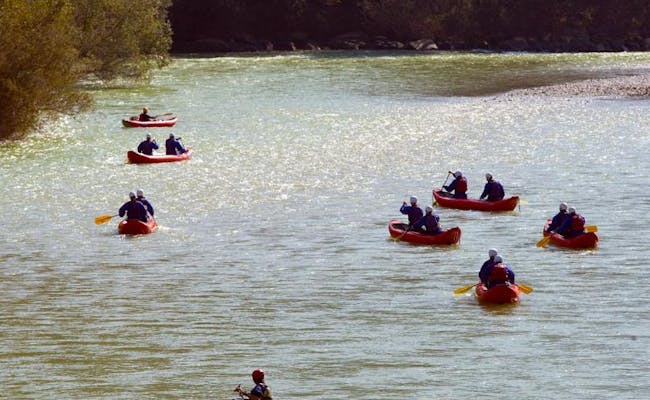 mehrere Schlauchboote Swissraft (Foto: Swissraft Tessiner Tourismusagentur ATT SA)
mehrere Schlauchboote Swissraft (Foto: Swissraft Tessiner Tourismusagentur ATT SA)The most popular spot for boating on the Rhine is the section between Stein am Rhein and Schaffhausen. It's about 18 km long. Diessenhofen is roughly in the middle and can also be used as a landing spot. The Upper Rhine is especially loved for its romantic backdrop.
Schaffhausen with the Rhine Falls is a special highlight. At 23 meters high and 150 meters wide, the Rhine Falls is one of the largest and most water-rich waterfalls in Europe. Neuhausen (behind the Schaffhausen power plant) serves as a starting point for boating, taking you to Rheinau (10 km) and Rüdlingen (20 km) and starts right at the Rhine Falls.
A boat trip between Rheinau and Eglisau is about 16 kilometers long. In the densely wooded gorge on both sides, you can spot beavers and kingfishers. After carrying the boat around the Eglisau power plant, continuing on to Hohentengen/Kaiserstuhl is straightforward. However, paddles need to be used on this stretch.
On the further stretch to Koblenz/Waldshut, there is a dangerous rapids called Koblenzer Laufen near Kadelburg. It is therefore not suitable for self-organized boating. However, guided boating tours through the Koblenzer Laufen are offered.
For Böötle tours, it is important to know the suitable boarding points beforehand.
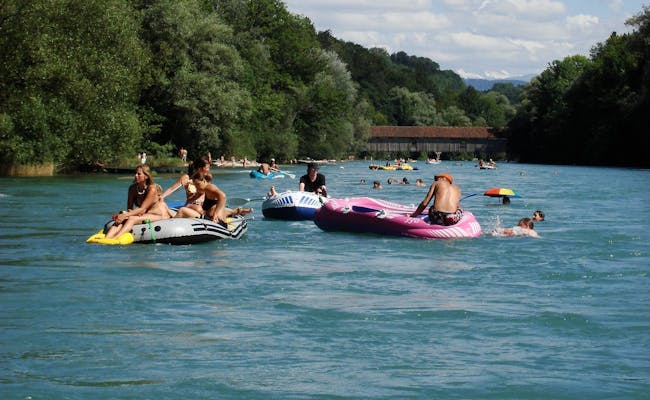 Rhein
Rhein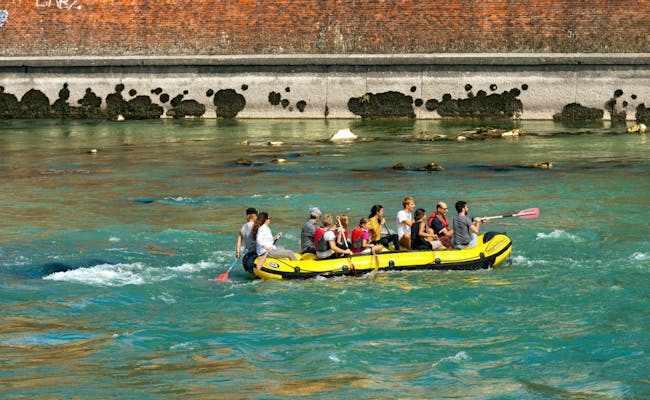 Stein am Rhein
Stein am RheinThe Ticino is channeled in the last few kilometers before it flows into Lake Maggiore and flows especially calmly. The banks are fortified, and reed belts line the river towards the lake. The current also eases off here. After getting off the raft, you can enjoy a sundowner at the beach bar.
The tours are either taken between Cresciano and Bellinzona or Bellinzona and Magadino and last 1.5 or 2.5 hours for 10 and 16 kilometers. The Ticino River is also called Tessin. The Tessin mountains tower above you during the rafting.
The water level at Bellinzona is ideal for a rafting trip at 15-100 m3/s.
The initially wild Ticino from Cresciano flows past gravel banks and wooded slopes that invite you to grill. Rafting at low water levels is not recommended.
In Cresciano, a path below the sports field leads to the shore at the entry point. You can get there from Bellinzona via Castione to the Cresciano, Paese bus stop. Then continue on foot.
You can reach the entry point Bellinzona by going to the bridge from the bus stop “Bellinzona, Via Lepori.” From there, you're right at the water.
Shortly after starting in Cresciano, there are some rapids. Be careful of venomous vipers among the rocks, and after the Passerella di Claro-Gnosca on the left, there is a stone weir.
On the stretch between Bellinzona and Magadino, there are no hazard areas except for some large rock formations in the water.
The exit point Bellinzona is located near a bus stop. You can also get off already at Arbedo. In Arbedo, the Moësa River flows into the Ticino right after the highway bridge; you can get off to your left just after the confluence. From the exit point, it's about a 10-minute walk to the Arbedo, Molinazzo bus stop.
Magadino is already in Lake Maggiore. As soon as you arrive over the Ticino in Lake Maggiore, aim for the white church of Magadino. Below it is a small peninsula where you can get off. The bus stop “Magadino, Casa Comunale” is just a few steps up the main road.
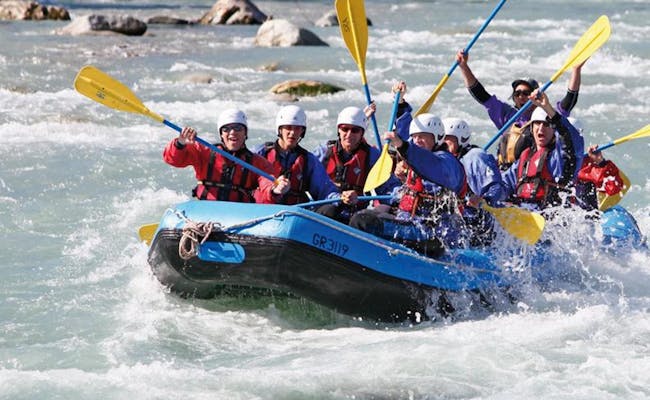 Ticino Swissraft (Foto Swissraft Tessiner Tourismusagentur ATT SA)
Ticino Swissraft (Foto Swissraft Tessiner Tourismusagentur ATT SA) Ticino Swissraft (Foto Swissraft Tessiner Tourismusagentur ATT SA)
Ticino Swissraft (Foto Swissraft Tessiner Tourismusagentur ATT SA)The Glatt is only 38.5 km long, but it’s long enough for a nice boat trip through nature. The river drains the Greifensee into the Rhine. The about eight-kilometer stretch between Rümlang and Oberhöri is great for a rubber boat ride, but there’s also a spot to get out in Oberglatt halfway through. Overall, the trip takes about three hours. You can use an interesting article with a little map for preparation.
The ride goes along Zurich Airport and offers unique views of arriving and departing planes of all kinds. The nature reserve and the east-west runway of the airport create a nice contrast. The river bends from Oberglatt to Niederglatt are particularly beautiful.
In Rümlang, you walk from the train station to the Garbabrücke, following the signs towards the Glatt riverside paths. Then, you can launch your boat down the stairs to the right of the Garbabrücke on Klotenerstrasse.
Under the railway bridge at Niederglatt, you need to be prepared for stronger currents.
In Oberglatt, after leaving the airport area, head right after the wooden Hirschenbrücke. Just before that, the Himmelbach river joins in. After the mud silos of the Fischbach-Glatt sewage treatment plant, the last exit comes up. You’ll leave the Glatt on the left side under the road bridge at the bike path. Due to several weirs and structures with stone blocks, it’s not possible to continue from Oberhöri.
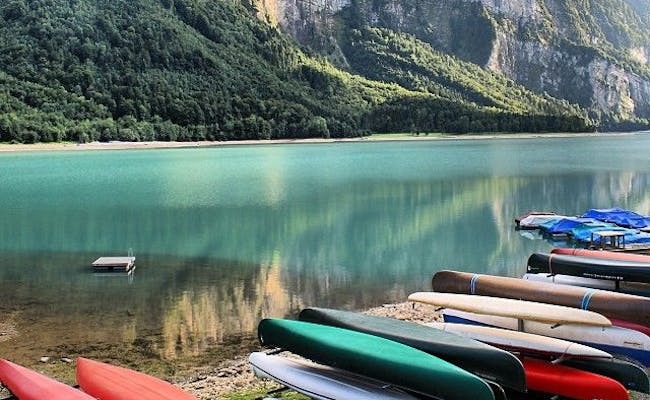 Glatt
Glatt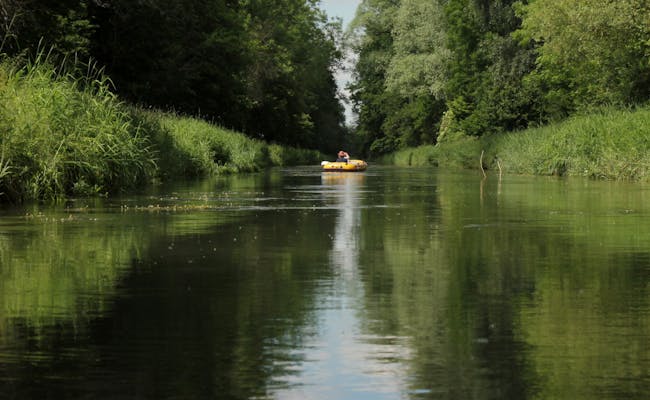 Glatt
GlattA rubber boat trip over the renatured canal between Weesen and Schmerikon is pure relaxation. The Linth connects the two lakes Walensee and Obersee/Zürichsee, partly via the Linth Canal, which is completely free of special danger spots.
The tours between Weesen or Ziegelbrücke and the Benken-Giessen island (15 km) or from Benken-Giessen to Schmerikon (7.2 km) can be combined in any way. Grynau (Uznach) is also a suitable entry and exit point. Between Grynau and Schmerikon, you have to paddle pretty well for about 35 minutes.
There are no critical danger spots.
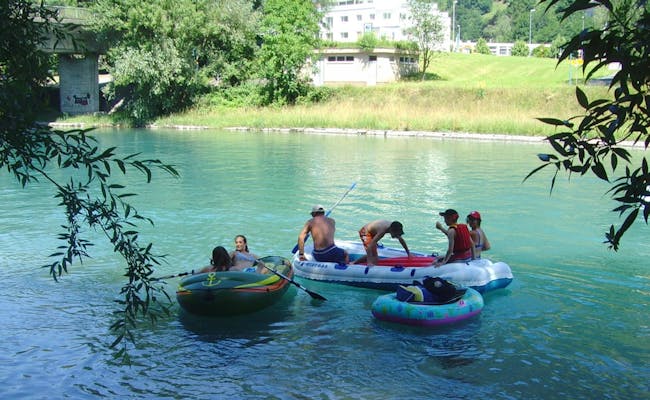 Zürich
Zürich Reuss Linth
Reuss LinthYou can use the Rhone for boating in Geneva between the Pont Sous-Terre bridge and Le Lignon. Besides beautiful and romantic bridges, you also have the unique backdrop of massive residential blocks that create a striking contrast.
The ride goes past the Jonction peninsula, where the Arve from the Mont-Blanc massif and the Rhône from Lake Geneva converge at its tip. After powerful rock walls on your right side, you eventually pass the Cité du Lignon.
This is a colossal complex, with its main block at 980 meters long, making it the longest residential building in Switzerland. The boating trip on the 5.5 km route takes about two to three hours.
You can get in at the Pont Sous-Terre bridge via a concrete ramp. From Geneva, you reach here by taking bus line 7 (direction "Vernier, Lignon-Tour") from the Geneva train station to "Délices". From there, walk straight to the Pont Sous-Terre bridge.
During the week, a large waste ship operates on the route three times a week; in that case, stay close to the shore.
The exit is on the right at the pedestrian bridge, the Passerelle du Lignon. From here, you can reach the bus stop "Vernier, Lignon-Cité" via the footpath to the Le Lignon settlement in about ten minutes. Bus line 7 runs every 15 minutes to Geneva.
 Reuss
Reuss Rhone
RhoneOn the Rheintal Inland Canal, you can paddle between Montlingen in St. Gallen all the way to Au, covering about 12 km on the shallow canal, without any hazards. You’ll enjoy the Bregenz Forest Mountains during the trip, which takes about three to four hours.
You’ll cross a former peat bog, now the Bannriet Nature Reserve. There’s a spot to land at a staircase on the left bank. Here, you'll find some shady trees and a grill area. Until you reach Au, the current is strong enough that you hardly need to paddle.
If you want, you can extend the boat trip another two kilometers to St. Margrethen, or even another 6 km to the mouth of the lake at Marina Altenrhein. However, the last few kilometers are very shallow and often blocked by trees. For this, you’ll need flat military inflatable boats, which can be rented from Steigmatt-Hof in Montlingen.
 Alter Rhein Böötle Rheintal (Foto Seraina Zellweger)
Alter Rhein Böötle Rheintal (Foto Seraina Zellweger)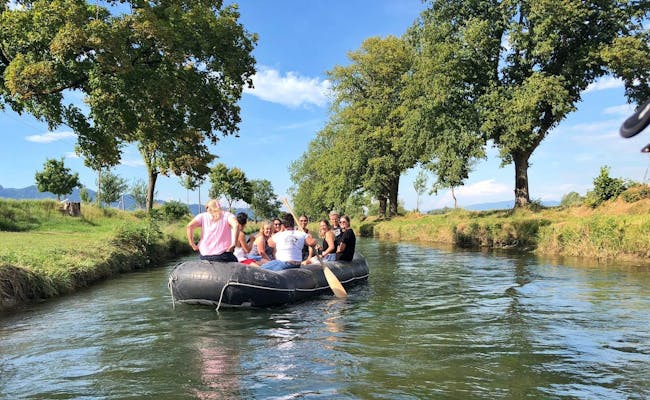 Rheintal Böötle (Foto Seraina Zellweger)
Rheintal Böötle (Foto Seraina Zellweger)The Thur is considered a wild stream and is partially suitable for a boat trip. The Thur on the way to the High Rhine is especially scenic. A really nice stretch goes from Gütighausen to Andelfingen. You’ll need about three hours to cover nearly ten km. If you’re not done yet, you can just keep going. In Flaach, you’ll find the last place to get out before flowing into the Rhine. After that, due to the Thurauen nature reserve before the inflow into the High Rhine, there’s no more exit point. Swimming is also not allowed here. The next exit is then in Rüdlingen after a total of 17 km and 4.5 hours.
The water level can rise quickly in the last section of the river after heavy rain in the source area. The recommended water flow rate is between 10 and 100 m3/s.
 Thur
Thur Thur Sonnenhof bei Dätwil
Thur Sonnenhof bei DätwilPhotos Source: